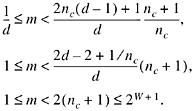10-9 Unsigned
Division by Divisors  1
1
Given a word size W
![]() 1 and a divisor d, 1
1 and a divisor d, 1 ![]() d < 2W, we wish to find the least integer m and integer p such
that
d < 2W, we wish to find the least integer m and integer p such
that
![]()
with 0 ![]() m < 2W
+ 1 and p
m < 2W
+ 1 and p ![]() W.
W.
In the unsigned case, the magic number M is given by
![]()
Because (22) must hold for ![]()
![]()
As in the signed case, let nc be the largest value of n such that rem(nc,
d) = d - 1. It
can be calculated from ![]() Then
Then
![]()
and
![]()
These imply that nc
![]() 2W - 1.
2W - 1.
Because (22) must hold for n = nc,
![]()
or
![]()
Combining this with (23) gives
![]()
Because m is to be the least integer satisfying (25), it is the next integer greater than or equal to 2p/d梩hat is,

Combining this with the right half of (25) and simplifying gives
![]()
The Algorithm (Unsigned)
Thus, the algorithm is to find by trial and
error the least p ![]() W satisfying (27). Then m is calculated from (26). This is the smallest
possible value of m satisfying (22) with p
W satisfying (27). Then m is calculated from (26). This is the smallest
possible value of m satisfying (22) with p ![]() W. As in the signed case, if (27) is
true for some value of p, then it is true for
all larger values of p. The proof is
essentially the same as that of Theorem DC1, except Theorem D5(b) is used
instead of Theorem D5(a).
W. As in the signed case, if (27) is
true for some value of p, then it is true for
all larger values of p. The proof is
essentially the same as that of Theorem DC1, except Theorem D5(b) is used
instead of Theorem D5(a).
Proof That the Algorithm Is Feasible (Unsigned)
We must show that (27) always has a solution
and that 0 ![]() m < 2W + 1.
m < 2W + 1.
Because for any nonnegative integer x there is a power of 2 greater than x and less than or equal to 2x + 1, from (27),
![]()
Because 0 ![]() rem(2p - 1, d)
rem(2p - 1, d) ![]() d - 1,
d - 1,
![]()
Because nc,
d ![]() 2W - 1, this becomes
2W - 1, this becomes
![]()
or
![]()
Thus, (27) always has a solution.
If p is not forced to equal W, then from (25) and (28),

If p is forced to equal W, then from (25),
![]()
Because 1 ![]() d
d ![]() 2W - 1 and nc
2W - 1 and nc
![]() 2W - 1,
2W - 1,

Hence in either case m is within limits for the code schema illustrated by the "unsigned divide by 7" example.
Proof That the Product Is Correct (Unsigned)
We must show that if p and m are calculated from (27) and (26), then (22) is satisfied.
Equation (26) and
inequality (27) are easily seen to imply (25). Inequality (25) is nearly the
same as (4), and the remainder of the proof is nearly identical to that for
signed division with n ![]() 0.
0.